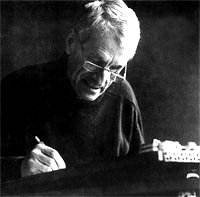S & H Concert Review
Xenakis: Designer in Sound, Nicolas Hodges (pf), Hilary Summers (mezzo), Linda Hirst (mezzo), Mark van de Wiel (bass clarinet), London Sinfonietta, Diego Masson, QEH, 7th October, 2003 (AR)
The London Sinfonietta opened their 2003/4 season with ‘Xenakis: Designer in Sound’ - a tribute to that radical explorer and creator of sounds, who died in 2001. With the Sinfonietta also celebrating the 20th year of its education programme dedicated to bringing contemporary music to a wider audience, 300 young pupils were invited to this concert as part of their Xenakis Project.The concert opened with Ohko, for three djembes, the composer’s fifth and last major percussion piece. The pulse and rhythm of West African drumming become transmogrified into a conflict between time and space, through the varying degrees of tension and density of sound, sometimes loud, sometimes soft. The three players constitute a unified body of sound one moment and then suddenly become conflicting forces, varying their attacks through intensity of sound; even in the quietest moments the tension of the piece remains. The playing itself had great magnetic intensity, invested with a kind of raw, nervous animal sexuality. The three drummers acquitted themselves superbly.
Next came Something Rich and Strange, a ten-minute film clip from film director Mark Kidel’s 50-minute documentary on the composer produced by the BBC in 1991. We see images of Xenakis juxtaposed with rather kitsch Greek Tourist Board images of goats and hillsides bathed in an aura of hazy light which seemed to run counter to extracts of the composer’s music. With Echange (1989) Xenakis moves away from the mathematical and architectonic – his trade marks – to the more lyrical and organic. Here the soundworld is one of violently contrasting textures with the woodwind sounding like razor sharp knives cutting through the silky textures of the other players.
Eonta (1963) could well be described as a choreographic poem for piano and brass. As a form of musical promenade theatre the brass players move around the platform as they play and on a couple of occasions they played into the piano itself. Xenakis makes the brass play in a very intense, distorted manner, taking their instruments to extremes in pitch, making extraordinary sounds, often appearing as if they were in conversation with each other. Some times, it seemed reminiscent of Giovanni Gabrieli and at others more like crowds of shouting people.
In part two we had a second excerpt from Kidel’s documentary Something Rich and Strange which focused on the composer’s war years, with violent but beautiful imagery of anti-aircraft search lights and gun fire and rioting students being fired upon by Germans, all of which influenced his music. Xenakis also recalls how he was wounded while attacking British tanks during the ‘liberation’ of Athens by the Allies, and how his brush with death led him to exile. Here the imagery and music worked much better together than in the earlier clip.
N’Shima (1975) - meaning breath or exhalation – is taken from a parable by Rabbi Nachman of Bratzlaw called The Emperor’s Daughter and the King’s Son (strikingly similar to Romeo and Juliet). However, Xenakis did not render the text literally and the two mezzo sopranos did not sing words but, as instructed, produced earthy, animal-like sounds, grunting and groaning complementing the more masculine sounding snarls and moans from the wailing horns. However I felt that the textures the women produced seemed rather pallid, with Linda Hirst especially having problems with articulation and projection. Somehow the writing for the voices sounded contrived and just did not come off, sounding far closer to Beckett’s theatre world. In the closing passage, the solo ‘cello of Sally Pendlebury had an extraordinary grainy quality, giving the sensation of a distant wind whirling round the female performers.
The concert concluded with Thallein (1984) - scored for sixteen instrumentalists - an exercise in the interweaving of complex and multiple sound-space structures and multi-layered strata and textures. Here it seemed as if the composer was using the spiralling architecture of shells and landscapes translated into sounds. The constant thuds from the piano seemed to serve as a skeletal structure about which the strings glide, slide and whirl in imploding vortices.
Throughout the entire concert, the conducting of Diego Masson was exemplary, a study in economy of gesture and total command of a fiendishly difficult programme. However, this inspired evening of musical theatre by the versatile London Sinfonietta would have been more appropriate in The Union Chapel or the Round House - the QEH acoustic was often too hard and dry for such intricate and intense sounds to emerge unscathed.
This concert will be broadcast on BBC Radio 3 in the near future.
Alex Russell

 Return to:
Return to: